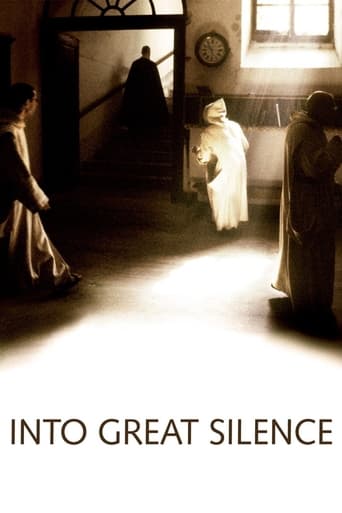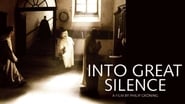dscottsw
Was a former postulant monk in a Benedictine community and, while the life was not for me, have been fascinated by all things monastic ever since. Saw this advertised somewhere a couple of years ago, wrote down the title - and finally got around to getting the DVD. After the first five or ten minutes - you start wondering if the sound is broken on the TV, until it dawns on you that you are entering into The Great Silence. I was deeply moved by the brothers, old, young and in between who participated in this film. For someone who wants to get an experiential sense of monastic spirituality, in its most ancient form - this film is a wonderful opportunity. How amazing to convey so much, with almost no words. A Beautiful film.
gentendo
I believe the director's purpose in making this documentary was for a multiplicity of reasons. One in which was to reflect on the beauty and simplicity of an exceptional culture and in the process exalt the everyday. Another reason was to know that God is by stilling the soul with silence and pondering upon his words, as demonstrated in one of the explicit scriptures shown: "Allow the stillness to enter in and know that he is." The following evidence will support both efforts made by the director.Whereas most Hollywood or even some independent films make their aim at reaching a conclusion (often called a climax, or resolution), Into Great Silence is not concerned about reaching any destination. It is simply about process and duration. It is concerned with becoming an observer—one who simply watches like a fly on the wall all of the events, activities, and services made explicit in the lives of real people. These people are not actors—they do not live anywhere near the limelight. They are ordinary yet unique individuals that live extraordinary lives. The camera work helps reflect this extraordinary realism by persisting with long and sometimes tedious shots of the monks going about their daily activities. The lighting is rather significant too. There are no stage light set-ups—simply all-natural. This choice by the director not only helps eliminate the man-made constructs of artificial lighting, but invites the viewer to become further absorbed in God's light—the only natural light there is.The simplicity of each shot sometimes seems mundane, but then again, so is real life from time to time. There is a beautiful sequence captured of rain pouring into an open puddle outside that helps the viewer appreciate the simple yet profound beauties of the earth. An editing choice of minimal ellipsis portrays the time elapsed from season to season as well. This preference helped exalt the seasons we often take for granted and gave reason to why we ought to praise God for creating such amazing sights to behold.This idea leads to the next purpose of why the filmmaker undertook this project. The idea of God being found in the silence of nature is extremely important throughout the film. In fact, about 90% of it is silent. It begins with a renowned scripture found in the book of 1Kings, which reads something to the effect like, "And the earthquake rent the mountain in twain, but God was not in the earthquake. Then came the fires but God was not in the fire. And then came the winds but God was not in the wind. And after all this came a still small voice, even the Holy Ghost." The idea of the Holy Ghost (God's voice) being represented as a still small voice gives definition to what this film is all about. Whereas the world would demand an astonishing vision or mind-blowing miracle to be converted to God's existence, the monks realized that it is in the depths of silence and solitude that God's spirit is able to commune with an open mind. The world, as is, is ridiculously noisy and hustled. The monks desire to retreat from it demonstrates their willingness to search after and discover God, as illustrated in another scripture shown: "You shall seek me with all your heart and I will allow myself to be found." An interesting symbol used in the film that brings out the idea of finding God in silence is portrayed through the use of the red candle burning brightly in the darkness. This image repeats itself multiple times to teach the viewer of the importance of being a light/influence unto a world of darkness. I believed this was to show how the silence of one's presence can strangely attract the mind of a darkened sinner. It is not through lip service that a person will be converted unto God, but through the actions one takes by being who they are—as reflected through the silence and lives of these diligent monks.
droveraj
I expected to get a minimum of understanding of life in the Grande Chartreuse, of what brings people there, of why they are so few, of how they maintain this immense edifice, of their role in the making and selling of their famous liquor, a good dose of Gregorian singing, an appreciation of the architecture. Instead I got 3 hours of sketchy, incoherent and repetitive shots. Three close ups of faces were repeated 4 times, the rope of the main bell was activated many times, a dark screen with flickering candles was seen too often, the shaving of monks heads is shot at length, including several minutes showing the barber (not shaved) looking flabbergasted ! Oh ! yes, they sell the liquor, because on the left of the monk using a laptop there is a letter in French from a Wines and Liquors company (seen for 5 seconds). The movie also had too many shots purposely and gratuitously out of focus. In short, an exercise in artiness leaving much to be desired. Two thumbs down.
donsmith-33
My wife and I had our first Sundance Cinema experience this week with a showing of Die Grosse Stille. The theater (brand new) is equipped with unbelievably comfortable chairs (not seats) that support the body with wonderful and relaxing ease. The film was, undoubtedly, our finest cinema experience ever. The almost three hour running time seem to slip by totally unnoticed as we were immersed in the lives of the Carthusian monks. Unfortunately for movie attendees in Madison (WI), this film played only one week and was gone. At our showing there were 12 persons in the theater; all were completely quiet and no outside sounds were heard. The best atmosphere to view this film. It was simply superb...all aspects of the monastery life were there for us to share. We will eagerly look forward to the DVD (US version) when it comes out later this year. Definitely not a movie for everyone but for those in the right frame of mind, a must see!!


